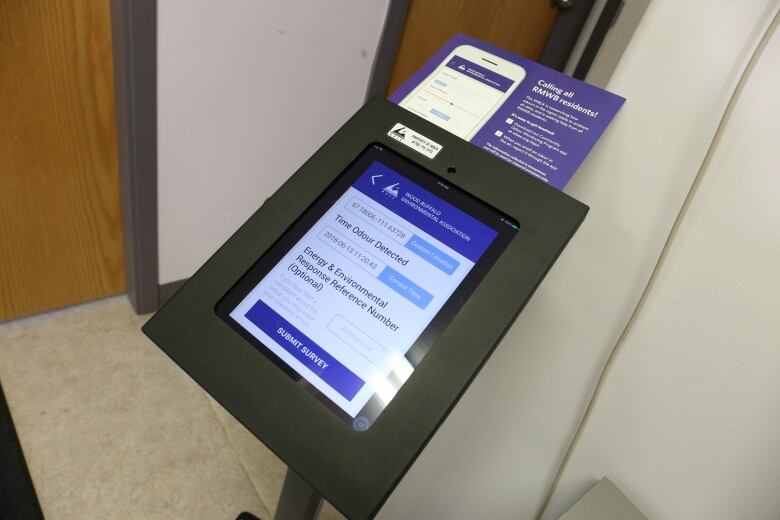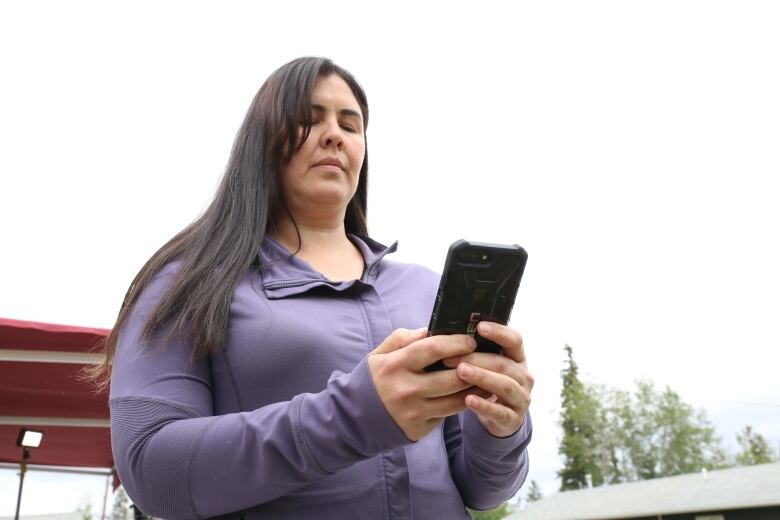'Smells like strong cat pee': Smartphone app tracks oilsands odour complaints
'We haven't seen this application anywhere else,' says director of Wood Buffalo Environmental Association

As often as twice a week, Melinda Stewart smells fumes from nearby oilsands plants that surround the Fort McKay First Nation, north of Fort McMurray.
"The sulphur smells like rotten eggs," said Stewart, who lives in Fort McKay. "The ammonia smells like strong cat pee."
Stewart said the odours are so bad thatcommunity members no longer hang their clothes outside, elders rarely go outdoors and many people are usingair purifiers in their homes.
In the past, residents had to call government agencies to report bad smells.

The Wood Buffalo Environmental Association (WBEA) even trained community members to sniff out and report offensive odours for the oilsands. They were nicknamed "nasal rangers."
Now the the nasal-ranger force has expanded and received a significant software update call it nasal ranger 2.0 thanks to a smartphone application.
A community odour monitoring programappintroduced by the association last fall allows anyone in the Fort McMurray oilsands region with aniPhone, Android phone or tablet to report odours. Within the first six months, 134 reports had been logged using the app.
'Crowd-sourcing odour frequencies'
The oilsands have long been a smelly problem for Fort McKay, a hamlet and a First Nation and Mtis community, and forother places within the Regional Municipality of Wood Buffalo.
But because air-quality events are so sudden, authorities often couldn't follow up because they were reported hours after an incident, or the location wasn't specific enough.
The app allows users to choose from a variety of smells including ammonia, asphalt and fuel.

The app then uses the phone's GPS to specify the location of the odour and the time. In Fort McKay, an iPad is set up at two community offices for those who don't have phones.
WBEAexecutive directorSanjay Prasad said information gathered via the app, combined with data from 25 air monitoring stations around the Wood Buffalo region, allows researchersto follow up complaints in real time.
"We are crowd-sourcing odour frequencies," Prasad said, "We haven't seen this application anywhere else."
Minimizing impact
On March 31, the app suddenly got multiple complaints about a tar-like smell.
Researchers looked at the the complaints andwere able to link them withincreased flaring at an oilsandsplant.
Ryan Abel, Fort McKay's First Nation's regulatory and technical manager in the sustainability department, said he hopes data from the app and the measurements from monitoring stations will help oilsands sites understand the sources of odours and how to eliminate them.

"We'll be able to look at when these events are occurring and hopefully connect that back to the work that's already going on," Abel said. "And connecting it back to what are the big things causing these issues, and how do we work to resolve them."
- MORE FORTMcMURRAYNEWS:'Anxious to get it over with': UCP wants Fort McMurray byelection to be called
- MORE FORTMcMURRAYNEWS:Fort McMurray airport suing insurer for $34M over losses in wildfire
- MORE FORTMcMURRAYNEWS:'Cowardly act': Afghanistan war monument vandalized in Fort McMurray
Stewartdoesn't think her community, surrounded byboreal forest,will ever return to continuous days of clean, fresh air. But she hopes a balance can be found.
"We cannot fix this because of our location. We can't pick up and move. This is home, and with industry around us they can't move," shesaid.
"So the next best thing is finding out where the odour is coming from and try to mitigate that."
Connect with David Thurton, CBC'sFort McMurraycorrespondent, onFacebook,Twitter,LinkedInor email him atdavid.thurton@cbc.ca












_(720p).jpg)


 OFFICIAL HD MUSIC VIDEO.jpg)
.jpg)



























































































